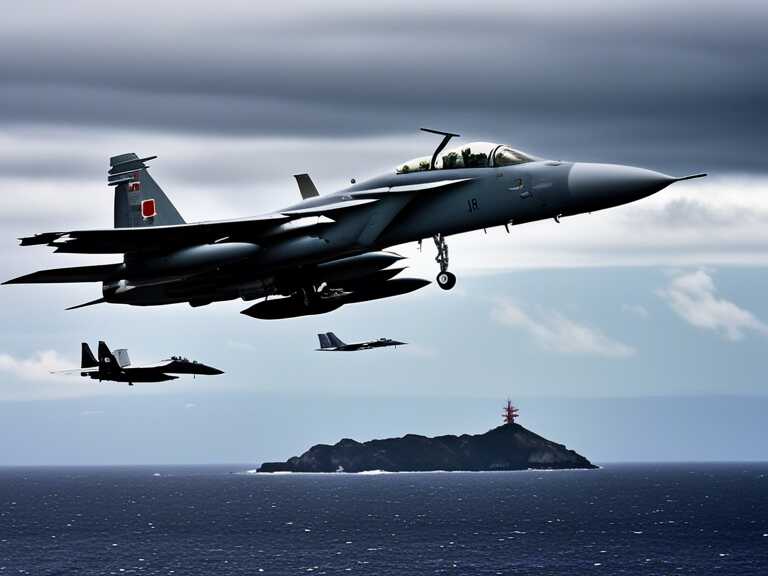
China's Military Aircraft Violates Japanese Airspace, Escalating Regional Tensions
Japan scrambled jets after a Chinese military aircraft violated its airspace, escalating regional tensions amid growing military cooperation between China and Russia.

Japan has reported an incursion into its airspace by a Chinese military Y-9 surveillance aircraft, escalating regional tensions. The incident, which occurred at 11:29 a.m. on Monday, August 26, 2024, involved the aircraft violating Japanese airspace above the Danjo Islands in Nagasaki Prefecture for a duration of two minutes, according to local media.
Military Responses and Diplomatic Repercussions
Japan's defense ministry swiftly responded to the violation by deploying fighter jets on an emergency basis and taking steps such as issuing warnings to the Chinese aircraft. The Japanese military released a photograph of the Y-9 reconnaissance plane, as depicted in a photo provided by Japan's Ministry of Defense. The incident prompted Japan's deputy foreign minister, Masataka Okano, to summon China's acting ambassador later that day and lodge a firm protest. Okano also called for measures to prevent future recurrences, according to the foreign ministry's statement. In response, the Chinese diplomat assured that the matter would be reported to Beijing, as relayed by the Japanese foreign ministry.
Recent Incidents and Responses
Japan's military has experienced a surge in scrambling jets between April 2023 and March 2024, with approximately 669 incidents reported, of which approximately 70% involved Chinese military aircraft. It is worth noting that this figure does not include instances of airspace violations. In a related context, last month, two Russian Tu-95 bombers and two Chinese H-6 bombers were reported to have entered the Alaska Air Defense Identification Zone, necessitating interception by U.S. F-16 and F-35 fighter jets, as well as Canadian CF-18s and other support aircraft, as confirmed by a U.S. defense official to CBS News.
Japanese defense officials have expressed increasing concerns about the growing military cooperation between the Chinese and Russian air forces. They are particularly apprehensive about China's assertive activities in Japanese waters and airspace, leading Tokyo to significantly reinforce its defenses in southwestern Japan, including key remote islands that play a crucial role in Japan's defense strategy in the region.
Regional and Global Implications
China's expanding economic and military influence in the Asia-Pacific region, coupled with its assertiveness in territorial disputes, especially regarding Taiwan, has raised alarms in the United States and its allied nations. In response to these developments, Japan, traditionally known for its pacifist stance, has increased its defense spending with the encouragement of the United States. This shift includes efforts to acquire "counter-strike" capabilities and an easing of rules on arms exports.
Notably, in April, President Biden and Japanese Prime Minister Fumio Kishida announced plans for closer military and intelligence cooperation. Japan is also actively providing funding and equipment, including patrol vessels, to countries across the region. Additionally, in July, Japan reached an agreement with the Philippines to allow troop deployments on each other's soil, further solidifying its regional military collaborations.
Strengthening Alliances and Regional Cooperation
Japan and South Korea have been making notable strides in strengthening their alliance despite historical tensions. Furthermore, Japan is a key player in the Quad alliance, which includes the United States, Australia, and India, serving as a counterbalance to China's regional ambitions.
Military Implications and Intelligence Gathering
In light of the recent airspace incursion by the Chinese Y-9 reconnaissance plane, experts have speculated that the aircraft may have been probing Japan's air defense network, collecting electronic intelligence such as radar signals and coverage. This underscores the growing sophistication of military activities in the region and the potential for further escalations.
Territorial Disputes and Tensions
Japan and China have engaged in tense encounters in disputed areas, particularly around the Senkaku Islands in the East China Sea (known as the Diaoyu Islands in China). The presence of Japanese coastguard vessels
, Chinese fishing boats, Chinese coastguard vessels, a naval ship, and a nuclear-powered submarine has been reported in the area. The Senkaku Islands have been the site of diplomatic tensions and confrontations between Japanese and Chinese vessels. Additionally, there have been instances of Chinese non-military aircraft, including a propeller-powered plane and a small drone, entering airspace near the Senkaku Islands in 2012 and 2017.
The latest incident at the Danjo Islands, a group of small islets off Japan's southern Nagasaki region, further exacerbates the already contentious situation. Japan's position is compounded by China's assertive claims in the South China Sea, a critical maritime region through which a substantial portion of global trade transits annually.
China's Assertiveness in the South China Sea
China's assertion of control over almost the entirety of the South China Sea has sparked international disputes, particularly in relation to its claims near the disputed Sabina Shoal, located 90 miles west of the Philippine island of Palawan and about 750 miles from China's Hainan Island. Multiple confrontations have occurred around the Sabina Shoal, where both China and the Philippines have stationed coast guard vessels, with concerns from the Philippines about China's potential plans to build an artificial island in the area.
Efforts to Manage Bilateral Tensions
In an effort to manage bilateral tensions ahead of the upcoming US elections in November, U.S. National Security Advisor Jake Sullivan is set to visit Beijing for three days, during which he will meet China's foreign minister, Wang Yi. This diplomatic engagement reflects the ongoing global efforts to address the multifaceted challenges posed by regional and geopolitical dynamics.
Share news















